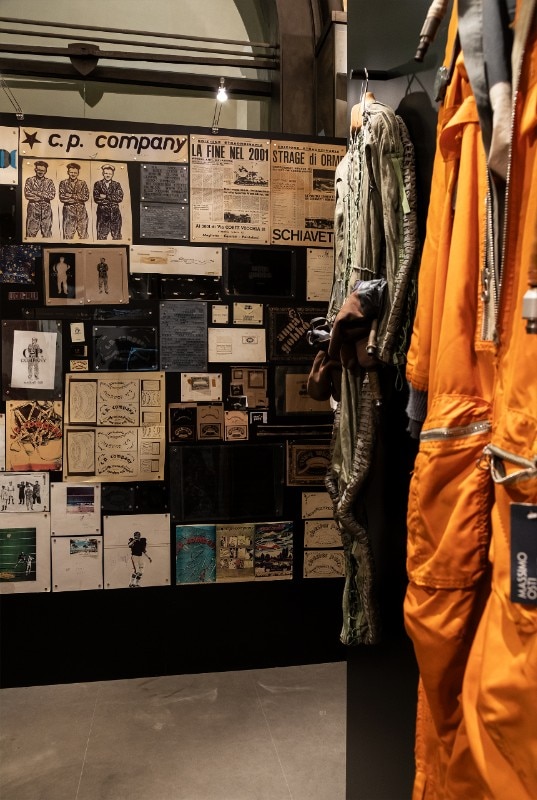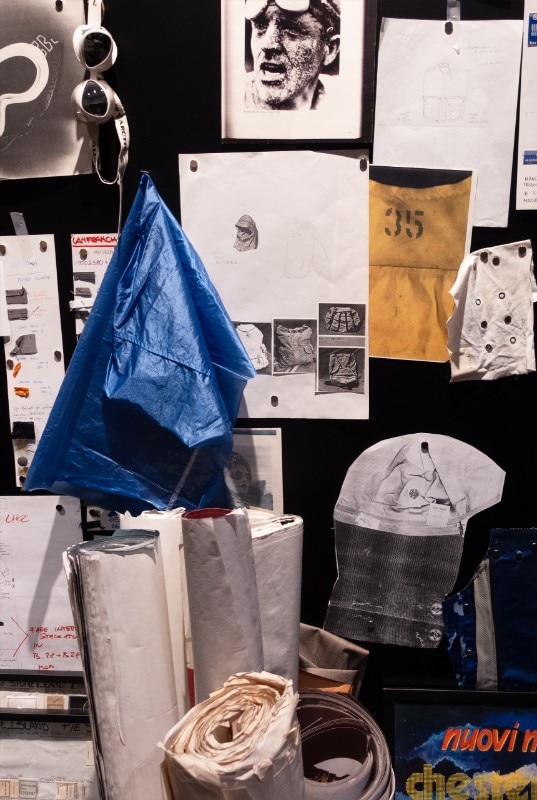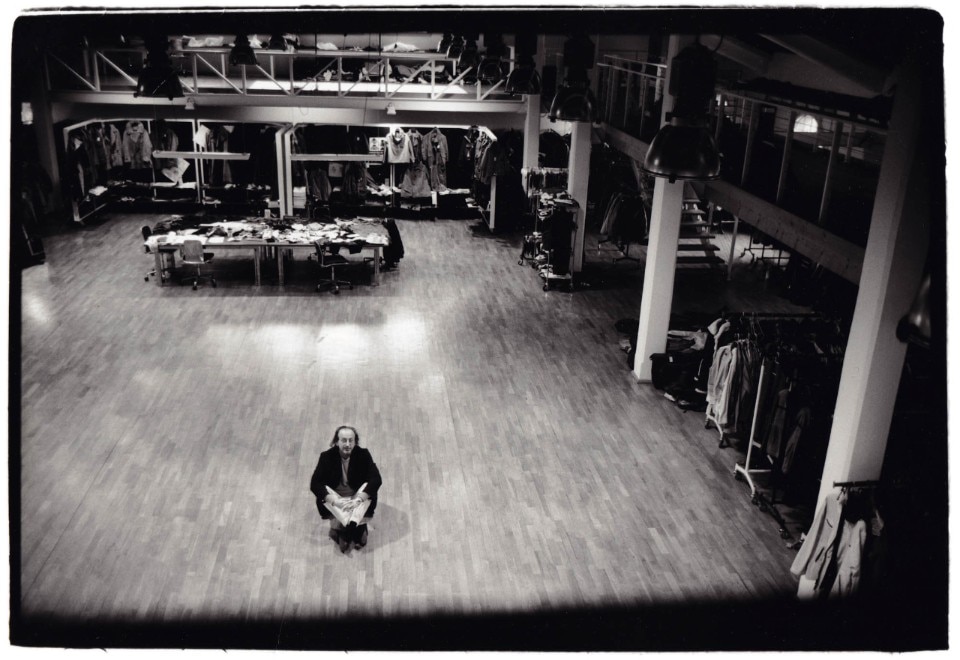In 1979, Sardinian artist and situationist Graziano Origa made an unofficial agreement with Andy Warhol to bring Interview Magazine to Italy. This led to the birth of Punk Artist, a publication that took inspiration from New York and blended it with a distinctly Italian attitude, rich in serigraphed artworks, Polaroids and spanning across music, fashion and glamorama.
Just a year earlier, in Bologna, Massimo Osti – born in 1944 – had launched C.P. Company, the brand that would seal his status just over ten years after his fashion debut. A debut far removed from academies, degrees and tailoring workshops, shaped instead by a diploma in graphic design earned through evening classes. This marked the beginning of his first venture: Chomp Chomp, American-style screen-printed promotional t-shirts, the likes of which had never been seen in Italy before. They were a hit, although far away from his hometown of Bologna. The clubs of Sardinia – where crowds of tanned youngsters danced barefoot on tables in white flared trousers – signalled the brand’s success, in a time in which the island was animated by the Aga Khan and his jet-setting entourage, and the likes of Luigi Vietti and Jacques Couelle were reshaping the island’s look with their organic architecture.
In true Warholian fashion, Osti was seduced by pop and mass culture, by comic books and photocopiers. Shortly after, in 1971, Chester Perry was born. The brand was named after the factory where Bristow, the protagonist of the eponymous British comic strip by Frank Dickens – published in Italy in Linus – worked. Osti, the illusionist and visionary, screen-printed weaves and textures directly onto garments, gifting cotton polos and t-shirts with unprecedented three-dimensionality and trompe l’oeil effects.
In Osti once can trace Warhol, yes, but above all punk. By the end of the ‘70s, the scene found a hotbed in Bologna with acts like Skiantos and Gaznevada, squatted venue Traumfabrik, label Italian Records, and underground comics, with Osti’s friends Andrea Pazienza, Tanino Liberatore and Filippo Scozzari composing the backbone of cult magazine Frigidaire.
One of the publication’s leading comic characters was Ranxerox – half human half Xerox machine. Osti, indeed, screen-printed, but more than anything, photocopied. He photocopied details from military and workwear garments – 35,000 of which he would collect and study over the years, travelling the world – cut and pasted them onto prototype jackets to visualise new concepts. Osti sampled field jacket pockets, early 20th-century military goggles, and zips to assemble new paradigms for the clothing of the future, foreseeing that the trenches of tomorrow would be the hectic cities of today. In this, he was extraordinarily punk – “muscles and scissors”, just like the title of the anthology on Stefano Tamburini, another essential name of the Frigidaire universe and 1980s Bolognese iconography.

This process is well documented in Ideas from Massimo Osti. From Bologna, beyond fashion, an exhibition born from the collaboration between Massimo Osti Studio, C.P. Company and the Massimo Osti Archive, which has just opened at Palazzo Pepoli in Bologna and on show until 28 September.
At the heart of the curatorial concept lie the three cornerstones of Osti’s poetics: innovation, research, and experimentation, as legendary Vogue Italia editor-in-chief Franca Sozzani once wrote about the designer. Greeting visitors is a reconstruction of Osti’s studio, where order emerged from disorder. The room is filled with clippings, notes, archive garments ready to be reinvented, and the ever-present photocopies. One shows a Royal Navy machinist, taken from a book of military uniform illustrations, which in 1978 became the now familiar C.P. Company logo. That happened after Fred Perry threatened legal action over the near-identical name Chester Perry.
Speaking of C.P. Company, the exhibition features the first ever model of the 1000 Miglia, also known as the ‘Goggle Jacket'. The piece was inspired by the outfitting etiquette of the drivers of the historic car race, an immarcescible Emilian-Romagnol topos, also celebrated by Federico Fellini in Amarcord (1973) and bolognese singer-songwriter Lucio Dalla in his album Automobili (1976).
Another of his early albums was titled Terra di Gaibola (Land of Gaibola), the very place where Osti had his studio in the 1980s – choosing the hills over the city, like all true Bolognese, as Franca Sozzani once pointed out.
Dalla is one of the artists to whom the designer was most deeply connected. His ideas travelled the world, his outerwear conquered the terraces of English football grounds and the streets of New York, yet Bologna (and Italy) always remained his identity’s fulcrum. After all, the world would not exist without the provinces, the global without the local. Before Eric Cantona and Noel Gallagher, it was Luca Carboni who wore Stone Island. Osti featured on the cover of the C.P. Company magazine crooner and tv personality Renzo Arbore and Lucio Dalla, for whom he designed both album artworks and stage costumes. Most notably, the yellow and green screen printed short sleeve shirts for the Banana Republic tour alongside Francesco De Gregori, a symbolic turning point between the Years of Lead and the roaring 1980s of Yuppies and Paninari to come.
In Osti’s universe, fashion is never an end in itself. In another issue of the C.P. Company magazine readers could learn about the Boxel P488, an electric race car designed by architect Paolo Pasquini, with which the Massimo Osti Studio pioneered the debate on sustainable mobility and took part in the Electric and Solar Vehicle Grand Prix in Rome in 1984. On a scribbled note resurfaced from the archive, we instead find the designer’s plans for a new Vespa scooter.

As an outsider to conventional fashion, Osti could turn the most unexpected objects, including shower curtains and truck tarpaulins, into fabric sources. Photocopies fuelled his pursuit of worn-out garments and lived-in look, far removed from the glossy and made-up perfection of fashion magazines. Even the campaigns were a family affair, with photographs taken by his wife, Daniela Facchinato, a photojournalist more drawn to subcultures than to fashion itself.
Osti, the punk and the illusionist. With garment dyeing, the designer rewrote the rulebook, realising that clothes could be dyed after they were assembled, and not the other way around as traditionally done. This allowed him to create pieces with unique tonal variations and, crucially, to drastically cut the production costs of individual models.
The technological advancement, along with the development of the Tela Stella fabric, became the founding element of Stone Island, the brand born in 1982 with a name rooted in Joseph Conrad’s novels: a manifesto of its exploratory spirit.
One of the brand’s classics, the Zeltbahn Cape from 1982, was inspired by a 1930s German army tent. It encapsulates the brand’s philosophy according to which form always follows function, and never the other way around. This approach continued across the many sartorial ventures Osti embarked on after his departure from C.P. Company in 1995: Massimo Osti Production, Massimo Osti, and M.O. Double Use.
Standing out is the ICD+ collection (Industrial Clothing Division), a line developed in 2000 for Levi’s in collaboration with Philips, the culmination of Osti’s futuristic drive, as the dawn of the new millennium finally seemed to catch up with his vision. Among the pieces was a breathable polyester raincoat with heat-sealed seams, foldable like a backpack around a nylon utility vest, and equipped with a Philips kit including a mobile phone, MP3 player and control pad. A totally wired vision that condensed into a single garment the cyberpunk spirit of Frigidaire’s RanXerox and the frenzy for the millennium bug. But once again, Osti was too far ahead of his time. The collection failed to make an impressione and, also because of his high production costs, soon took off the market.
In the twenty years since his passing, fashion finally seems to have caught up. Much is owed to the attention that over the years his work has relentlessly received in the United Kingdom, both in the form of subcultural camaraderie and academia. As a matter of fact, the Menswear Archive at the University of Westminster in London, curated by Prof. Andrew Groves, is home to the largest collection of Osti’s garments outside of Italy.
Ideas from Massimo Osti succeeds in illustrating Osti’s philosophy beyond the realm of fetishised garments, bringing the designer back to the heart of his native Bologna.

Opening image: Massimo Osti, photographed by Daniela Facchinato.


